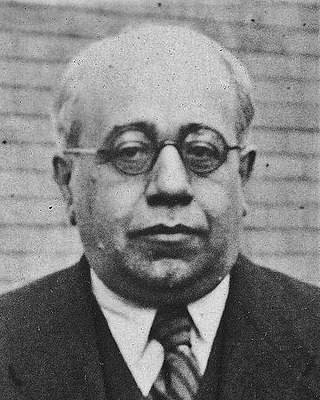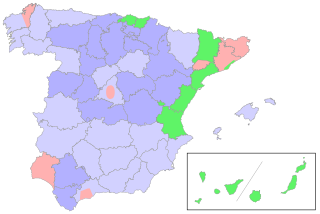
Manuel Azaña Díaz was a Spanish politician who served as Prime Minister of the Second Spanish Republic, organizer of the Popular Front in 1935 and the last President of the Republic (1936–1939). He was the most prominent leader of the Republican cause during the Spanish Civil War of 1936–1939.

Alejandro Lerroux García was a Spanish politician who was the leader of the Radical Republican Party. He served as Prime Minister three times from 1933 to 1935 and held several cabinet posts as well. A highly charismatic politician, he was distinguished by his demagogical and populist political style.

Augusto Barcia y Trelles was a Spanish politician, several times member of the Congress of Deputies, who served as acting Prime Minister of Spain from 10 May 1936 to 13 May 1936 due to former PM Manuel Azaña being elected as President of the Republic. He was also a lawyer and a Freemason.

The Radical Socialist Republican Party, sometimes shortened to Radical Socialist Party, was a Spanish radical political party, created in 1929 after the split of the left-wing in Alejandro Lerroux's Radical Republican Party. Its main leaders were Marcelino Domingo, Álvaro de Albornoz, and Félix Gordón Ordás.

Legislative elections were held in Spain on 16 February 1936. At stake were all 473 seats in the unicameral Cortes Generales. The winners of the 1936 elections were the Popular Front, a left-wing coalition of the Spanish Socialist Workers' Party (PSOE), Republican Left (Spain) (IR), Esquerra Republicana de Catalunya (ERC), Republican Union (UR), Communist Party of Spain (PCE), Acció Catalana (AC), and other parties. Their coalition commanded a narrow lead over the divided opposition in terms of the popular vote, but a significant lead over the main opposition party, Spanish Confederation of the Autonomous Right (CEDA), in terms of seats. The election had been prompted by a collapse of a government led by Alejandro Lerroux, and his Radical Republican Party. Manuel Azaña would replace Manuel Portela Valladares, caretaker, as prime minister.

Elections to Spain's legislature, the Cortes Generales, were held on 19 November 1933 for all 473 seats in the unicameral Cortes of the Second Spanish Republic. Since the previous elections of 1931, a new constitution had been ratified, and the franchise extended to more than six million women. The governing Republican-Socialist coalition had fallen apart, with the Radical Republican Party beginning to support a newly united political right.

Melquíades Álvarez Gónzalez-Posada was a Spanish Republican politician, founder and leader of the Reformist Republican Party (Partido Republicano Reformista), commonly known just as Reformist Party and President of the Congress of Deputies between 1922 and 1923.
The Liberal Republican Right was a Spanish political party led by Niceto Alcalá-Zamora, which combined immediately with the incipient republican formation of Miguel Maura just before the Pact of San Sebastián, of which they formed a part, as Alcalá-Zamora was elected president of the Provisional Government of the Republic. After the proclamation of the republic, it participated in the 1931 general election among the lists of the combined republican-socialist coalition, receiving 22 seats.

Álvaro de Albornoz y Liminiana was a Spanish lawyer, writer, and one of the founders of the Second Republic of Spain.

Republicanism in Spain is a political position and movement that holds that Spain should be a republic.
The Federal Democratic Republican Party was a Spanish political party founded in 1868 during the Glorious Revolution that was active until 1912. Its ideology was federal republicanism and progressivism.
The Progressive Republican Party was a Spanish political party created in 1880 by Manuel Ruiz Zorrilla. Ruiz Zorrilla wrote his testament in January 1895 declaring his successor, and thus the reins of the party were passed to José María Esquerdo upon Ruiz Zorrilla's death. The latter helped to create the Republican Union in 1903. Following the death of Esquerdo, the party dissolved in June 1912, integrating into the Reformist Party of Melquíades Álvarez and Gumersindo de Azcárate.

Eduardo Ortega y Gasset (1882–1965) was a Spanish politician, journalist and lawyer.
Vicente Fatrás Neira was a Spanish politician. In his younger years he was also one of Spain's first racing cyclists.

Luis de Zulueta y Escolano (1878–1964) was a Spanish Republican politician, pedagogue and diplomat. He was linked to the Institución Libre de Enseñanza. He served as Minister of State from 1931 to 1933, during the Second Republic.

Rafael Salazar Alonso was a Spanish lawyer, newspaper proprietor and politician who engaged in left-wing and right-wing politics. He was the mayor of Madrid and a government minister. He was executed by the Republican authorities two months after the Spanish Civil War started.
The Republican Alliance was a Spanish political platform that brought together several republican parties and groups during the dictatorship of Primo de Rivera. The alliance was formed on 11 February 1926, and consisted of four political groups ranging in various types of republicanism:

Marcelino Domingo Sanjuán was a Spanish teacher, journalist, and politician who served as a minister several times during the government of the Second Spanish Republic.
The IndependentRadical Socialist Republican Party was a minor Spanish radical political party, created in 1929 after the split of the left-wing of the Radical Socialist Republican Party. Its main leaders were Marcelino Domingo, Álvaro de Albornoz and Ángel Galarza.
The Nombela scandal or Nombela affair was a corruption scandal during the Second Spanish Republic. The scandal had a serious political impact on the coalition government of the Radical Republican Party and CEDA, due to many distinguished members of the Republican Party, including its leader Alejandro Lerroux, being associated with it. The scandal, was one of the factors that contributed to the fall of the government and the 1936 elections. It took its name by the person who brought it into light, Antonio Nombela.











